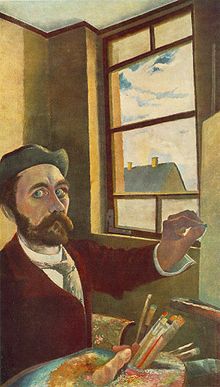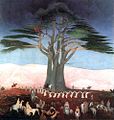- Tivadar Kosztka Csontváry
-
The native form of this personal name is Csontváry Kosztka Tivadar. This article uses the Western name order.
Tivadar Kosztka Csontváry 
Self-portrait (around 1900)Born July 5, 1853
Kisszeben, Kingdom of Hungary (now Sabinov, Slovakia)Died June 20, 1919 (aged 65)
Budapest, HungaryNationality Hungarian Field Painter Movement Post-Impressionism, expressionism Tivadar Kosztka Csontváry (Hungarian pronunciation: [ˈtivɒdɒr ˈkostkɒ ˈt͡ʃontvaːri]; born 1853 - d. 1919) was a Hungarian painter[1]. He was one of the first Hungarian painters to become well known in Europe.
Csontváry was born on 5 July 1853 in Kisszeben, Sáros County, Kingdom of Hungary (today Sabinov, Slovakia), and died 20 June 1919 in Budapest. His ancestors were Poles who settled down in Hungary.[2] Although Csontváry was obsessed with his Magyar roots, he himself grew up speaking Slovak mixed with German.[3] He was a pharmacist until his twenties. On a hot sunny afternoon, 13 October 1880, — when he was 27 years old — he experienced a mystic vision. He heard a voice saying "you will be the greatest sunway painter, greater than Raphael!" He took journeys around Europe, visited the galleries of the Vatican, then went home to collect money for his journeys working as an apothecary. From 1890 onwards he traveled around the world. He visited Paris, the Mediterraneum (Dalmatia, Italy, Greece), North Africa and the Middle East (Lebanon, Palestine, Egypt, Syria) and painted pictures. He painted his major works between 1903 and 1909. He had some exhibitions in Paris (1907) and Western Europe. Most of the critics in Western Europe recognized his abilities, art and congeniality, but in the Kingdom of Hungary during his life he was considered to be an eccentric crank for several reasons, e. g. for his vegetarianism, anti-alcoholism, anti-nicotinism, pacifism, his latent, but more and more apparent schizophrenia and his cloudy, prophetic writings and pamphlets about his life (Curriculum), genius (The Authority, The Genius) and religious philosophy (The Positivum). Even though later he was acclaimed, during his lifetime Csontváry's visionary, expressionistic style found little understanding. A loner by nature, the master's mental balance was upset by his “failure” impairing his creative power. Little did he know that some years after his death, an entire museum in Pécs, Hungary, would be devoted to his paintings, and that worldwide appreciation of his works would be in constant ascendancy. Many painters, e.g. Picasso added a stone to Csontváry's cairn.
He painted more than one hundred pictures, the most famous and emblematic of which is probably Magányos cédrus (The Lonely Cedar). His art connects with post-impressionism and expressionism, but actually he was an autodidact and cannot be classified into an exact style — he regarded himself as one of the "sunway"-painters (this word was created by him). He was one of the most eccentric and most considerable Hungarian painters.
The Kieselbach galery from Budapest,Hungary sold on 15 December 2006 in an auction the most expensive Csontvary painting so far. The in 1902 painted "Meeting of the lovers" or "Randevú" was bought by an unknown customer for more than one million EUR.
Contents
A quote
- "I, Tivadar Kosztka , who gave up his prime of youth for the rebirth of the world, accepting the call of the invisible Spirit, had a regular civil job, comfort, wealth then (...) Going to Paris in 1907 I oppositely standed alone in front of millions with only the result of the divine providence, and I beat the vanity of the world hollow, but I haven't killed 10 million people, only sobered them, I haven't made commercials from things, because I didn't care for the pedlar's press; I retired from the world instead, going to the top of the Lebanons, and I painted cedars."
- T., Cs. K.: The Positivum.
Gallery
-
Pilgrimage to the Cedars of Lebanon, 1907, Hungarian National Gallery, Budapest
-
Csontváry Museum, Pécs
References
- ^ Mansbach & V. West 1991, p. 101
- ^ Valentiner, Wilhelm Reinhold (1965). The Art quarterly. 28. Detroit Institute of Arts. p. 247. "Tivadar Kosztka — he was a descendant of old Polish aristocracy who settled in Hungary"
- ^ The Hungarian quarterly. MTI. 1997. p. 40. http://books.google.com/books?id=Bh0QAQAAMAAJ&q=kosztka+slovak+mixed+german&dq=kosztka+slovak+mixed+german&hl=sk&ei=y854TqPXD4rHsgaR56SsCw&sa=X&oi=book_result&ct=result&resnum=1&ved=0CCwQ6AEwAA. Retrieved 20 September 2011.
Sources
- Mansbach, Steven A.; V. West, Richard (1991). Standing in the tempest: painters of the Hungarian avant-garde, 1908-1930. Santa Barbara Museum of Art. ISBN 9780262132749.
External links
Categories:- 1853 births
- 1919 deaths
- People from Sabinov
- Hungarians in Slovakia
- Hungarian painters
- Symbolist painters
- "I, Tivadar Kosztka , who gave up his prime of youth for the rebirth of the world, accepting the call of the invisible Spirit, had a regular civil job, comfort, wealth then (...) Going to Paris in 1907 I oppositely standed alone in front of millions with only the result of the divine providence, and I beat the vanity of the world hollow, but I haven't killed 10 million people, only sobered them, I haven't made commercials from things, because I didn't care for the pedlar's press; I retired from the world instead, going to the top of the Lebanons, and I painted cedars."
Wikimedia Foundation. 2010.




